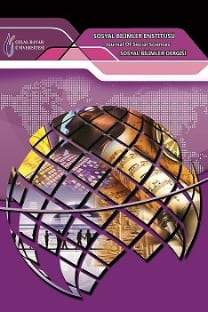Kamu Göç Yönetiminde Türk İltica ve Menşe Ülke Bilgi Sistemi
Günümüzde ülkelerin önemli bir konusu haline gelen göç sorunu, insanlık tarihinin başlangıcından beri var olduğu söylenebilir. Göç, başından beri insanlık tarihinin bir parçası olmuştur. Bu nedenle İnsan hareketleri ve özellikle yasadışı geçişler bölgesel sınırlar çizildikten sonra önemli konular haline gelmişlerdir ve çözümlenmesi gereken birer kamu yönetimi konusu olmuşlardır. Türkiye göç süreci ve bu sürecin geçiş noktasında coğrafik, psikolojik, yönetsel ve daha birçok bakış açılarında gelişmeye ihtiyacı olan bir ülke durumdadır. Özellikle göç sürecini yönetmek için kamu yönetiminde yeni ve özgün yapılara ihtiyaç bulunmaktadır. Ülkemizde göç alanında uzun yıllardır bilgi ve deneyim sahibi olan Emniyet Genel Müdürlüğü Yabancılar Hudut ve İltica Daire Başkanlığı tarafından güncel gelişmiş ülke sistemlerine uygun olarak çalışmalar yapılmıştır. Çalışmada güncel sistemlere uygun olarak İltica ve Menşe Ülke sistemleri ve ülkedeki bu sistemlere uygun olarak geliştirilen sistem ve sistem kurgulanırken başvurulan kaynak ve metotları(n) ortaya konması hedeflenmiştir. Geçici sığınmacılık ve mültecilik alanında çalışan; özellikle polis, kamu yönetimi ve hukuk alanında görev yapan süreç yönetici ve düzenleyicileri, avukatlar, hakim ve savcılar, diğer eğiticiler için yeni bir kavram olan Menşe Ülke Bilgi Sistemide ele alınmıştır.
Anahtar Kelimeler:
Yasadışı göç, iltica sistemi, menşe ülke bilgisi, kamu yönetimi, göç yönetimi
Kamu Göç Yönetiminde Türk İltica ve Menşe Ülke Bilgi Sistemi
Human mobility, in particular, illegal entrances in aftermath of making of the borders has been an important concern and subject for countries Turkish migration processes, at the very transformatory point, are in a state of need for developing a wide of array of perspectives, geographic, administrative and a multitude of disciplinary perspectives. There exists an overwhelming need for novel and original structures to manage migration processes, specifically speaking. Different studies have been carried out up to contemporary standard by the Directorate of Turkish National Police Aliens, Border and Asylum Department renowned for its knowledge and experience in such matters of migration. From the perspective given, resources and methods referred in the making of the system and systems developed in countries making use of Asylum and Country of Origin up to day’s standards shall be discussed and elaborated in detail. In addition, the system of Country of Origin Information, a new concept for those, especially for police, public administrators, attorneys, judges, educators and lawyers working in the fields of asylum seekers and refugees shall also be a matter of discussion.
Keywords:
Illegal migration, asylum system, country of origin information, public administration, migration management,
___
- BRADY, H. (2008), EU migration policy:An A-Z, Centre for European Reform (CER), London.EriĢim tarihi:01.01.2013. http://gees.org/documentos/Documen-02874.pdf.
- CASTLES, S. & MILLER, M.J. (2003). The Age of Migration: International Population Movements in the Modern World, Basingstoke: Palgrave Macmillan.
- COLLETT, E. (2009), Beyond Stockholm: overcoming the inconsistencies of immigration policy, EPC WORKING PAPER No.32.
- GYULAĠ, G. (2007). Country Information in Asylum: ProceduresQuality as a Legal Requirement in the EU, Hungary: Hungarian Helsinki Committee.
- HOVY, B. (1993). Asylum migration in Europe: patterns, determinants and the role of East-West movements, In R.King (Ed.), The News Geography of European Migration (ss.207–227). London⁄New York: Belhaven Press.
- ICMPD, (2002). Practical Guide to the Effective Gathering and Usage of Country of Origin Information, ICMPD in the framework of the EU Odysseus project: Seminar on the Effective Usage of Country of Origin Information in the EU Candidate States.
- KERR, S. P. & WĠLLĠAM, R. K. (2008). Economic Impacts of Immigration: A Survey. HBS Working Paper 09-013: 1-37.
- PENNĠNX, R., SPENCER, D. &Hear, N. V. (2008). Migration and Integration in Europe:The State of Research, ESRC Centre on Migration, Policy and Society (COMPAS) University of Oxford.
- STALKER, P. (2002). Migration Trends and Migration Policy in Europe. International Migration, 40(5):151–179.
- TRĠANDAFYLLĠDOU, A, (2010), Controlling Migration in Southern Europe (Part 2): Gate-keeping Strategies (ARI), Demography, Population and International Migrations ARI 8/2010.
- UN, (2002). International Migration, Department of Economics and Social Affairs, Population Division. New York: United Nations.
- ISSN: 1304-4796
- Yayın Aralığı: Yılda 4 Sayı
- Başlangıç: 2003
- Yayıncı: Manisa Celal Bayar Üniversitesi
Sayıdaki Diğer Makaleler
Yrd. Doç. Dr. İhsan Cemil DEMİR, Araş. Gör. Yıldıray GÜLTEN
Türk Şiirinde İzmir (1850-1950)
Konaklama İşletmelerinde İş Doyumu, Yaşam Doyumu ve Öz Yeterlilik Arasındaki İlişkinin Analizi
İlköğretim Öğrencilerinin Sınıf ve Cinsiyete Göre Sınav Kaygı Düzeylerinin Belirlenmesi
Osmanlının Görsel Şiirleri Üzerine Özer Şenödeyici'den Akademik Bir İnceleme
Küresel Ekonomide Çok Uluslu Şirketler ve Türkiye'deki Yansımaları
Türk-Alman İlişkilerinde Türk İmajını Meydana Getiren Olgular ve Eserlere Yansıması
Hazır Giyim Sektöründe En İyi Fason İşletme Seçimi İçin AHP ve VİKOR
